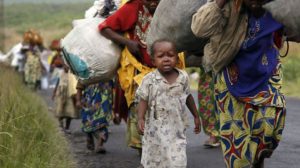The world’s forgotten refugees
 With more than 65 million people around the globe displaced from their homes and an unprecedented number conflicts triggering humanitarian crises from Myanmar to the Mediterranean, some of these human tragedies are receiving more attention than others.
With more than 65 million people around the globe displaced from their homes and an unprecedented number conflicts triggering humanitarian crises from Myanmar to the Mediterranean, some of these human tragedies are receiving more attention than others.
The plight of Syrians escaping the conflict in their homeland and Rohingya people forced into exile in Bangladesh have received blanket media coverage.
But, in response to the notion that some of these crises are being ignored by the international community, the Norwegian Refugee Council (NRC) has produced a report identifying the five most neglected displacement crises – all of them in Africa.
Launching the report this week, Secretary General of the NRC Jan Egeland said that humanitarian relief should be given according to needs alone. But Mr Egeland said this was not happening.
“Need should be the principle that donors adhere to but it is not,” he said.
NRC created the list after it examined 24 large displacement crises globally.
Countries were ranked based on the lack of three criteria: will of armed groups and the international community to broker peace agreements and find political solutions; the level of media attention the crisis receives in comparison to its size; and the amount of funding received.
Mr Egeland said one of the issues that crises in Africa face, is that they are less visible to donor countries.
- The Democratic Republic of the Congo (DRC)
While the DRC has suffered conflicts for decades, the violence has reached an unprecedented level in recent years — leading to the largest number of people displaced the country has ever seen.
At the end of last year, there were 4.5 million people internally displaced and another 700,000 who had fled the country.
Some 8.9 million people don’t have access to food and clean water in DRC and 2.2 million children are acutely malnourished.
Despite widespread human suffering, the humanitarian funding appeal was only about halfway funded last year. Aid organisations have also pulled out of several provinces. The situation is expected to worsen and spread throughout the Great Lakes region.
- South Sudan
The crisis in South Sudan has left over half of the population dependent on aid and pushed one-third of the population out of their homes.
More than 2.4 million people have fled to neighbouring countries to seek shelter. More people are without food than ever before in South Sudan and the humanitarian sector is raising alarm about the threat of famine.
Compounding these urgent needs is the difficulty in accessing populations in need.
South Sudan is increasingly difficult to operate in for humanitarian groups. The current conflict has claimed the lives of 100 aid workers, with nearly one-third of those deaths happening last year.
Media attention to the crisis has also decreased, partially due to government restrictions on foreign journalists.
- Central African Republic
Despite a ceasefire in 2014, a national reconciliation forum, and elections, the conflict in the Central African Republic has worn on, with an escalation in violence at the end of 2016.
More than 1.2 million people are internally displaced or living as refugees in neighbouring countries. This is one-fourth of the population.
The appeal was only 41 percent funded last year, making it one of the least funded major crises in 2017.
- Burundi
More than 400,000 people have fled Burundi since 2015 after violence erupted in response to President Pierre Nkurunziza’s announcement extending his presidency.
The number of refugees increased 20 percent last year. More than 3.5 million people are in need of assistance and one-fourth of the country does not have enough food.
Despite these needs, there have been only a few major international initiatives working to protect civilians or place pressure on forging a pathway towards a political solution.
- Ethiopia
Last year, Ethiopia suffered the worst drought it has faced in over 30 years, as well as a spike in insecurity in the Oromia and Somali regions. This led to the displacement of more than 1 million people.
Many communities were impacted by both the drought and conflict. Despite the double burden of crises, the international aid appeal was only 46 percent funded.
The government and humanitarian sector are warning of acute food insecurity for up to 7 million people if funding doesn’t come through.
- Others
Other neglected displacement crises highlighted by the report include the Palestinian Territories, Yemen, Venezuela, and Nigeria.
Laurie Nowell
AMES Australia Senior Journalist












